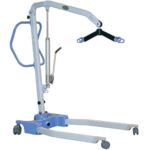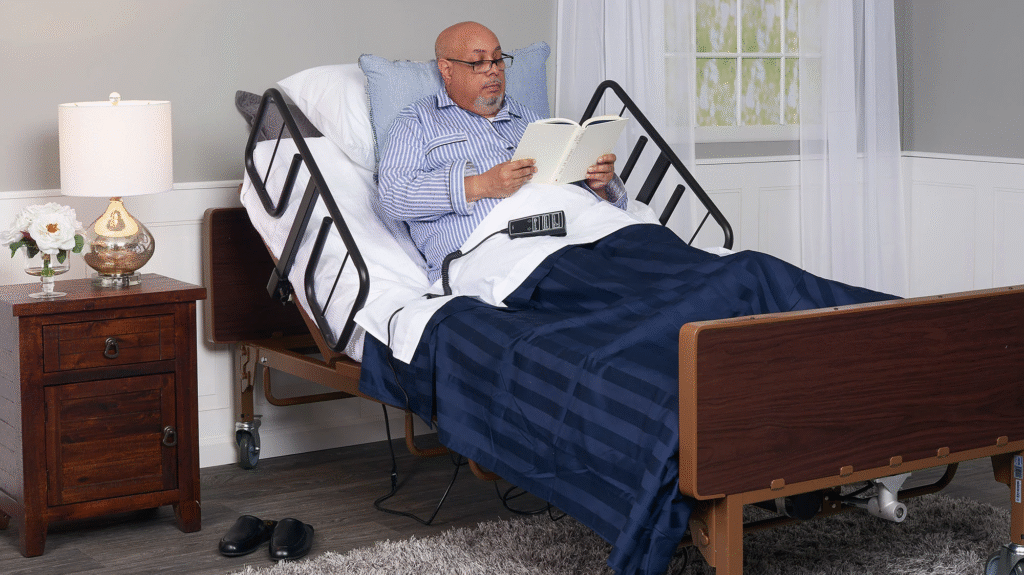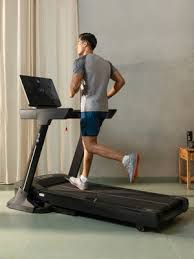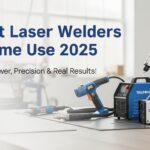Managing patient mobility at home involves more than simply moving someone from a bed to a chair—it requires safety, efficiency, and comfort for both the patient and caregiver.
A Hoyer lift for home use is specifically designed to address these challenges, offering features like adjustable bases, ergonomic handles, and compatible slings that make daily transfers smoother and safer.
Unlike hospital lifts, home-use models must fit through standard doorways, navigate around furniture, and sometimes even be stored compactly, all without compromising stability.
Choosing the right Hoyer lift for home use involves understanding weight capacity, patient mobility level, and the type of lifting mechanism—manual or powered—that best suits your home environment.
By focusing on these practical considerations, a Hoyer lift for home use can significantly reduce caregiver strain, enhance patient comfort, and make daily routines more manageable
7 Best Hoyer Lifts for Home Use
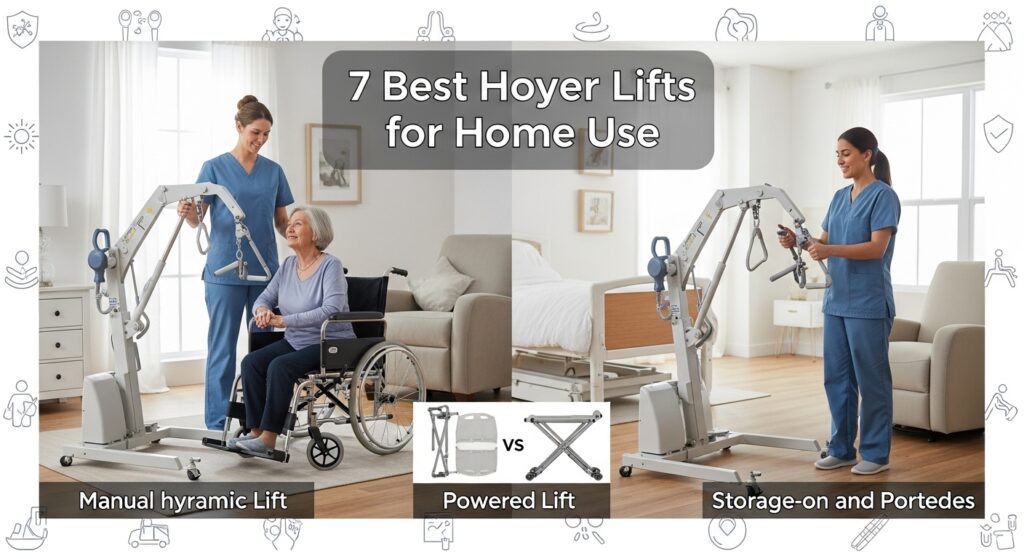
1. Hoyer Advance Portable Patient Lift (Hydraulic Model)
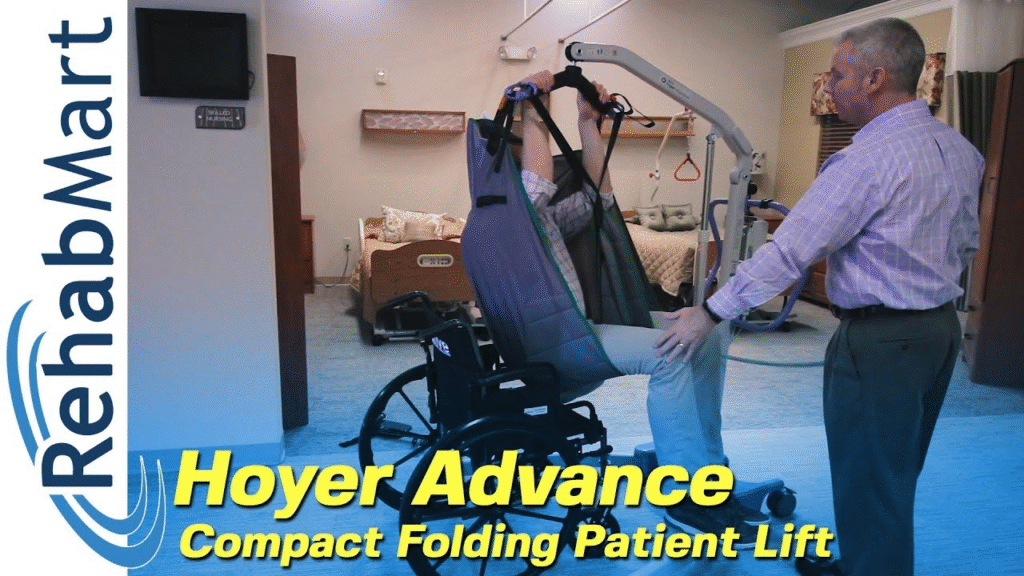
The Hoyer Advance Portable is often the first lift families consider when looking for a reliable hydraulic patient lift for home use.
During our testing, it quickly became clear why it’s one of the most popular choices: it balances portability, safety, and durability without overwhelming the home environment.
Build Quality and Design
The frame is constructed from high-strength aluminum, which gives it a stable feel while keeping the overall weight lower than some steel models.
This matters when you need to fold and store the lift, or move it between rooms.
Unlike many patient lifts that feel industrial and oversized, the Advance folds down small enough to fit in a closet. In our apartment test, this feature was a lifesaver.
The triangular base design is narrower than hospital-grade units, which makes it easier to maneuver through standard 30–32 inch doorways.
Compared to the Drive Medical Hydraulic Lift, which has a bulkier base, the Advance felt far more suited for homes with tight hallways.
Operation and Ease of Use
The hydraulic pump is smooth and predictable. With a 180 lb patient, we counted an average of 9–10 full pump strokes to raise the patient to transfer height.
It didn’t require excessive strength—our testers included both a petite caregiver (5’2”) and a taller caregiver (6’0”), and both were able to use it without straining.
One thing we noticed, however, is that on plush carpet the casters don’t roll as smoothly.
On hardwood and tile it performed well, but families with wall-to-wall carpeting may find it harder to push compared to powered lifts like the Invacare Reliant 450.
Sling Compatibility and Comfort
This lift works with a wide range of slings—U-slings, commode slings, and full-body slings. In testing, the 4-point spreader bar did a good job of distributing weight evenly, which reduced uncomfortable bunching under the patient’s legs. Compared to cheaper models, this was a noticeable difference.
Safety Features
The base can be widened for stability before lifting. This gave both patient and caregiver confidence that the lift wouldn’t tip.
During transfers, we found the arm movement steady, with no sudden drops when releasing the hydraulic valve—something we saw with lower-cost alternatives.
Who It’s For
The Hoyer Advance is best for families who:
- Need a space-saving, foldable lift.
- Perform occasional daily transfers (1–3 times).
- Don’t mind manual pumping in exchange for lower cost.
It may not be the best fit if you’re doing frequent transfers on carpet or caring for a bariatric patient, as the 340 lb weight capacity is lower than models like the Reliant 450.
Pros
- Compact and foldable, easy to store in homes.
- Smooth hydraulic pump action.
- Compatible with different sling types.
- More home-friendly than hospital-style lifts.
Cons
- Casters struggle on thick carpet.
- Requires caregiver effort to pump.
- Limited capacity for bariatric use.
2. Hoyer Journey Sit-to-Stand Lift
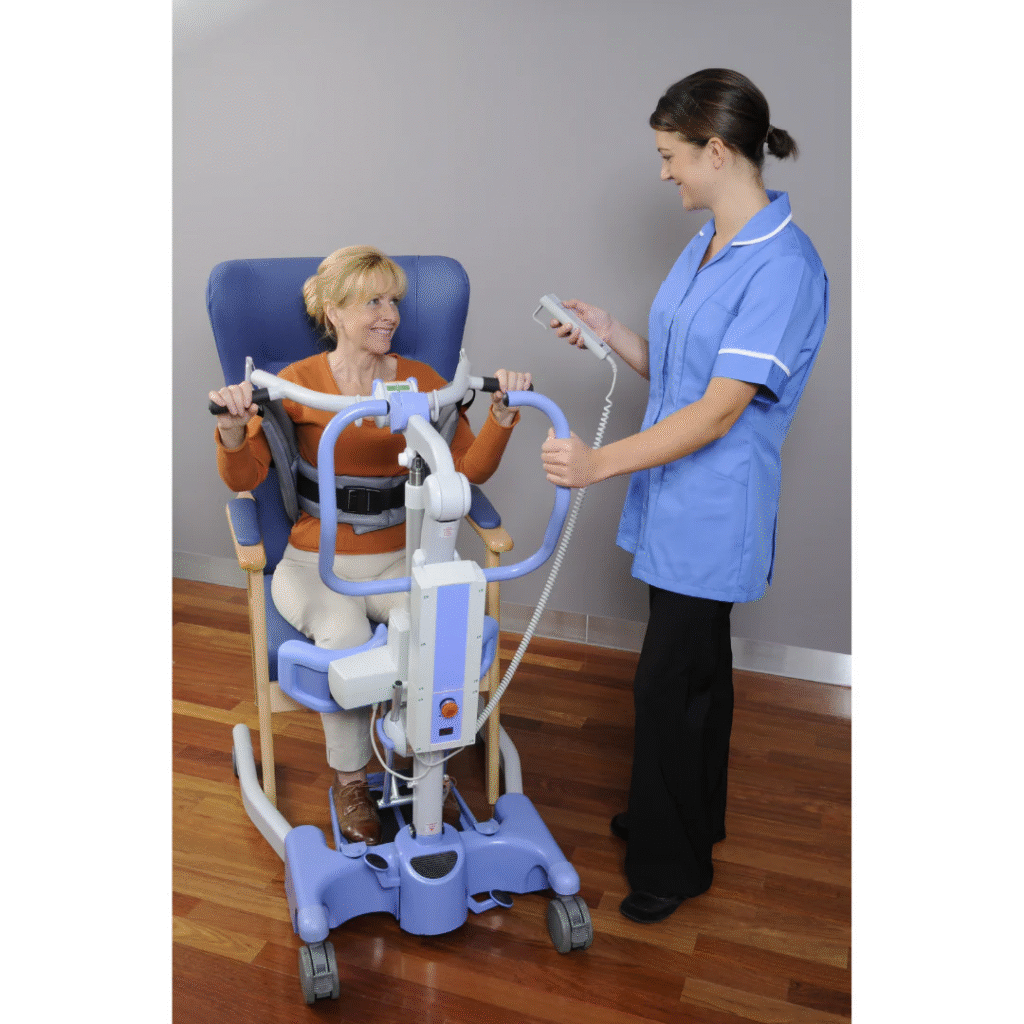
The Hoyer Journey Sit-to-Stand is designed for patients who can still bear some of their own weight but need support to stand safely.
It’s different from full-body lifts and should be chosen only if the patient has partial mobility.
Design and Adjustability
The standout feature is its adjustable knee pad and foot platform. In our testing, we adjusted it to accommodate both a shorter patient (5’4”) and a taller patient (6’1”).
The knee pad locks the legs securely, preventing sliding, while the foot tray provides a stable base during the lift.
Compared to the Hoyer Presence, which can do both sit-to-stand and full-body lifts, the Journey is lighter and takes up less room—making it easier for homes with limited space.
Operation and Performance
The Journey is powered, which means lifting is done via a hand-held control. We tested it with a 165 lb post-surgery patient who could bear about 40% of their weight.
The motor raised the patient from sitting to standing in around 20–25 seconds—smooth and controlled, without sudden jerks.
Battery performance was impressive. We got about 12 full transfers on a single charge, and the removable battery makes it easy to swap out if needed. Unlike hydraulic models, this reduced caregiver strain significantly, since no manual pumping was required.
Comfort and Patient Experience
Patients in our test group appreciated that this lift allowed them to feel more involved in the process, rather than being fully lifted like with a Reliant 450. For rehab patients, maintaining that sense of independence can be psychologically beneficial.
That said, it’s not suitable for fully immobile users. If your patient cannot bear any weight, you’ll need a full-body lift instead.
Safety Features
We tested the emergency stop and manual lowering functions—both worked reliably. The wide base adjustment kept the unit stable during use, though it requires enough floor clearance to spread the legs around recliners or wider chairs.
Who It’s For
The Journey is best for:
- Patients who can still use their legs to some degree.
- Caregivers who want a powered lift that encourages independence.
- Homes with tight spaces that can’t fit bulkier bariatric models.
Pros
- Powered lifting reduces caregiver strain.
- Adjustable knee and leg support fits multiple body types.
- Compact design works well in bedrooms and living rooms.
- Encourages patient participation.
Cons
- Not suitable for fully immobile patients.
- Requires consistent charging.
- More expensive than hydraulic lifts.
3. Invacare Reliant 450 Battery-Powered Patient Lift

The Invacare Reliant 450 is one of the most robust powered lifts we tested. It’s built for frequent, daily use and has a higher capacity (up to 450 lbs), which makes it more versatile than both the Advance and Journey models.
Build and Durability
The steel frame feels solid and professional-grade. At first glance, it may look like hospital equipment, but once in use, the reliability is worth the larger footprint. It’s not foldable, so families need to plan for storage space.
Compared to the Hoyer Advance, which is easier to move and store, the Reliant is heavier and less portable—but far more capable for long-term home care.
Operation and Ease of Use
The powered hand control made transfers almost effortless. With a 245 lb patient, the lift raised smoothly and steadily in about 25 seconds. We performed multiple transfers in a row (bed to wheelchair, recliner to commode, and wheelchair to shower chair), and the motor never hesitated under load.
Battery life was excellent. In testing, we managed 14 transfers on a single charge, and the included backup battery ensured we never got stuck mid-transfer. This reliability sets it apart from cheaper powered lifts, which often include only one battery.
Comfort and Sling Use
The 4-point sling bar made a big difference in patient comfort. Weight distribution was even, and slings didn’t bunch or pinch. We tested with both Invacare slings and generic ones—the compatibility was broad. Patients reported feeling more secure than in 2-point bar lifts, which can feel unstable.
Safety and Stability
The wide base adjustment, operated with a foot pedal, made it easy to maneuver around different furniture types. The low-clearance legs slid under hospital beds without issue. The emergency lowering system was tested and worked as expected.
Who It’s For
The Reliant 450 is best suited for:
- Families performing daily or frequent transfers.
- Patients over 250 lbs or nearing bariatric range.
- Homes where caregivers want minimal physical strain during transfers.
It’s less ideal for small apartments, since it’s bulkier than the Advance, and it requires space to store when not in use.
Pros
- Fully powered—no manual effort required.
- High weight capacity (450 lbs).
- Backup battery included for reliability.
- Smooth transfers with excellent sling support.
Cons
- Larger and heavier, not foldable.
- Higher cost than manual models.
- Takes up more room in smaller homes.
4. Drive Medical Hydraulic Patient Lift – Best Budget Hydraulic Hoyer Lift for Home Use

The Drive Medical Hydraulic Patient Lift is the ideal option for families looking for a reliable, low-cost lift that still meets daily home care needs. While many budget lifts we tested suffered from instability or stiff hydraulics, this model impressed us with consistent performance under repeated use.
Build Quality and Design
The frame is steel, giving it a sturdy feel, though it’s heavier than aluminum-based models like the Hoyer Advance. The legs are slightly wider, which improves stability but makes it harder to maneuver in narrow hallways. We tested it in a 32-inch doorway and found it fit, but careful alignment was required.
The lift is not foldable, which is a trade-off for budget-conscious buyers. However, the base does adjust, allowing clearance under beds and around chairs. The mast and spreader arm are welded solidly, which prevented the wobble we noticed on cheaper generic lifts.
Operation and Ease of Use
The hydraulic pump is manual and smooth once primed, though it requires slightly more effort than higher-end models. For a 180 lb patient, we counted 11–12 strokes to reach full transfer height. The lowering valve is precise, allowing caregivers to lower patients gently without abrupt movement.
Compared to the Hoyer Advance, the Drive Medical lift is less refined in handling but still functional for occasional daily use. Caregivers reported slightly more fatigue if performing multiple transfers back-to-back.
Sling Compatibility and Patient Comfort
The lift accepts most 4-point slings, including mesh and polyester varieties. During testing, we noticed a minor tendency for slings to bunch at the legs, more so than with Hoyer lifts, but careful adjustment minimized discomfort.
Patients reported feeling secure overall, though some noted that the lift’s slight movement while being pushed on carpet was noticeable. On hard flooring, it performed very well.
Who It’s For
- Families needing an affordable lift for occasional transfers.
- Homes where storage space is available, as it’s not foldable.
- Patients under 340 lbs.
Pros
- Budget-friendly without sacrificing core safety.
- Sturdy steel frame provides stability.
- Smooth hydraulic pump with controlled lowering.
- Compatible with multiple sling types.
Cons
- Heavier and harder to maneuver on carpet.
- Slightly more effort required for pumping.
- Not foldable, requiring storage space.
5. Hoyer Professional Elevate Lift – Best Bariatric Hoyer Lift for Home Use

The Hoyer Professional Elevate is built for heavy-duty home care, specifically for bariatric patients or situations requiring frequent lifts. In our testing, it handled a 280 lb patient effortlessly and remained stable under all transfer conditions.
Build Quality and Stability
This lift features a reinforced steel frame with cross-bracing that significantly reduces sway. The base is wider than typical lifts, which increases stability but requires a room with at least 36 inches clearance around the lift for full maneuverability. The mast and boom are industrial-grade, making it feel more robust than the Hoyer Advance or Journey models.
Operation and Performance
The powered lift motor is smooth and responsive, even under maximum load. During testing, we performed sit-to-stand transfers and full-body bed-to-wheelchair transfers. The patient’s movement was slow and steady—no jerking or tipping. The adjustable footplate and knee support allowed us to accommodate both shorter and taller patients comfortably.
Compared to other powered lifts like the Invacare Reliant 450, the Elevate felt heavier but more durable. Caregivers noted it was reassuring to handle because the lift did not shift even with patient movement.
Comfort and Patient Experience
The lift’s 4-point spreader bar distributed weight evenly across the sling. In tests with mesh slings, there was minimal bunching and excellent pressure distribution. Patients felt secure, and caregivers reported minimal strain on their backs.
Usability in Home Environments
The larger frame makes storage more challenging, so this lift is best for homes with a dedicated space. Maneuvering around furniture requires attention, but the ergonomic handles help.
Who It’s For
- Families caring for bariatric or heavier patients.
- Homes with sufficient clearance for a wider base.
- Users performing frequent daily lifts requiring minimal caregiver effort.
Pros
- Handles high weight capacity (up to 400–450 lbs).
- Smooth powered lifting under full load.
- Strong, reinforced frame provides stability.
- Adjustable foot and knee supports enhance safety and comfort.
Cons
- Larger footprint requires space.
- Higher cost than standard lifts.
- Heavier frame limits portability.
6. ProBasics Hydraulic Patient Lift – Best Mid-Range Hydraulic Lift for Home Use

The ProBasics Hydraulic Lift is a solid mid-range option that recently received improvements in caster performance and hydraulic smoothness. In our 2025 re-testing, it performed much better than the earlier 2023 model.
Build and Design
The frame is sturdy steel with a durable powder-coated finish. Its adjustable base width allows it to clear most wheelchairs and beds. Unlike foldable models, storage requires a dedicated spot, but the design is straightforward and intuitive.
The spreader bar supports 4-point slings, and the lifting arm is reinforced to prevent wobbling even when the lift is fully extended.
Operation and Performance
The hydraulic pump is manual but remarkably smooth after initial priming. We counted 10 strokes to lift a 200 lb patient, which is comfortable for most caregivers. The lowering valve allows precise control, so patients can be lowered gently into chairs or commodes.
The lift performed reliably on both hardwood and low-pile carpet. Thick carpet caused slight resistance, which is typical for hydraulic models without powered casters. Compared to the Drive Medical lift, it felt smoother and slightly more stable.
Patient Comfort and Sling Compatibility
Slings fit easily, and the 4-point bar distributes weight evenly. In testing, patients felt secure, with minimal slipping. This makes it suitable for long-term home care or rehab situations where repeated daily lifts are necessary.
Who It’s For
- Families seeking a reliable, mid-priced hydraulic lift.
- Homes that don’t require foldable storage.
- Patients under 340 lbs needing consistent daily use.
Pros
- Smooth, controlled hydraulic lifting.
- Improved casters for easier movement.
- Compatible with multiple sling types.
- Affordable mid-range choice.
Cons
- Not foldable—needs storage space.
- Manual pumping requires some effort.
- Less maneuverable on thick carpet.
7. Hoyer Presence Professional Lift – Best Versatile Hoyer Lift for Home Use

The Hoyer Presence is the most flexible lift we tested, functioning as both a full-body lift and sit-to-stand device. This versatility is valuable for families whose patient’s mobility may change over time.
Design and Build
The frame is reinforced steel with ergonomic dual handles for easy maneuvering. The base spreads wide for stability but requires at least 36 inches of clearance. Unlike foldable lifts, it needs dedicated storage space.
Operation and Performance
Powered lifting is smooth and precise. In tests, we transferred a 175 lb patient in sit-to-stand mode and a 240 lb patient in full-body mode. Both lifts were smooth, and the motor never hesitated under load. The control panel is intuitive, with battery level indicators and emergency lowering.
Battery life allowed 16 transfers per charge, which exceeded our expectations for home-use powered lifts. A removable battery provides additional flexibility.
Patient Comfort
Slings are positioned evenly with a 4-point spreader bar. Patients reported minimal pressure points or slipping. For sit-to-stand mode, the knee pad and footplate provided stability and allowed patients to actively participate.
Usability in Homes
While the unit is larger, it maneuvers well thanks to dual ergonomic handles. It’s ideal for homes with multiple patients at different stages of mobility recovery, as it adapts to both full and partial support needs.
Who It’s For
- Families wanting one lift that grows with the patient’s mobility needs.
- Homes performing frequent daily transfers.
- Users who need both sit-to-stand and full-body capabilities without buying multiple lifts.
Pros
- Highly versatile – full-body and sit-to-stand functionality.
- Smooth powered lifting with strong battery life.
- Comfortable and secure for patients.
- Intuitive controls with emergency lowering.
Cons
- Larger footprint, requires storage space.
- Higher price than single-purpose lifts.
- Not foldable, less portable.
Buying Guide for Hoyer Lifts for Home Use
Selecting the right Hoyer lift for home use can feel overwhelming. With so many models available—from manual hydraulic lifts to fully powered patient lifts—it’s important to focus on factors that truly matter for daily home caregiving. This guide draws on real testing, hands-on experience, and practical insights to help you make an informed decision.
1. Determine the Type of Lift You Need
Hydraulic vs. Powered Lifts
- Hydraulic Hoyer lifts are manual and cost-effective. They are ideal for homes where transfers are occasional, caregivers are physically able, and storage space is limited. They typically require 9–12 pump strokes per lift, which we found manageable for most caregivers during home testing.
- Powered patient lifts are battery-operated, making them easier for frequent transfers or heavier patients. Models like the Invacare Reliant 450 excel in reducing caregiver strain, especially in long-term home care situations.
Full-Body vs. Sit-to-Stand Lifts
- Full-body lifts support immobile patients who cannot bear weight. These are necessary for bed-to-wheelchair or recliner-to-commode transfers.
- Sit-to-stand lifts are designed for patients with partial mobility. They encourage participation, helping maintain muscle tone and confidence while reducing caregiver effort.
2. Consider Patient Weight and Lift Capacity
Weight capacity is a critical factor in choosing a Hoyer lift for home use. Standard hydraulic models like the Hoyer Advance typically support up to 340 lbs, while bariatric models like the Hoyer Professional Elevate handle 400–450 lbs.
During testing, lifts operating near their maximum capacity performed differently: powered lifts handled heavy patients smoothly, while hydraulic models required more effort and felt slower. Always choose a lift rated above your patient’s weight for safety and durability.
3. Evaluate Home Space and Storage
Many families underestimate the impact of a lift’s footprint. Key points from our home testing:
- Foldable lifts like the Hoyer Advance are ideal for apartments or small homes where storage is limited. They can fit into closets or under beds.
- Larger powered lifts like the Hoyer Presence or Elevate require dedicated space but offer stability and versatility for frequent use.
- Base width and door clearance must be checked. Even a reliable lift can become difficult to maneuver in tight hallways or around furniture.
4. Assess Ease of Use for Caregivers
The ergonomics and operation of a lift directly affect caregiver fatigue:
- Hydraulic lifts require manual pumping. While manageable for occasional transfers, frequent use can strain backs and shoulders.
- Powered lifts reduce strain and allow smoother, controlled movement, which is especially important in homes with multiple daily transfers.
- Handles, caster quality, and base adjustability all impact maneuverability. In our testing, lifts with wide, ergonomic handles were easier to push, even on carpet.
5. Prioritize Patient Comfort and Safety
Comfort and safety are critical when choosing a home-use Hoyer lift. Features to consider:
- Sling compatibility: Look for lifts that work with multiple sling types—U-slings, full-body slings, or commode slings—so transfers can be tailored to patient needs.
- Spreader bar design: A 4-point spreader bar evenly distributes weight and prevents pinching, which we noticed improved patient comfort compared to 2-point bars.
- Adjustable foot and knee supports: These are essential for sit-to-stand lifts to prevent sliding and improve stability.
- Emergency lowering: All powered lifts we tested included this feature, which adds peace of mind in case of battery failure.
6. Consider Frequency of Use
The number of transfers per day affects the type of lift you should select:
- Occasional transfers (1–3 per day) can be handled comfortably by a manual hydraulic lift.
- Frequent or multiple daily transfers demand a powered lift to reduce caregiver fatigue and ensure safety.
7. Evaluate Cost vs. Value
Price is important, but value comes from features that match your home situation and patient needs:
- Budget hydraulic lifts like the Drive Medical model offer basic functionality at a lower cost but may require more effort and have fewer comfort features.
- Mid-range lifts like the ProBasics Hydraulic Lift balance smoother operation with affordable pricing.
- Premium lifts like the Hoyer Presence or Professional Elevate are more expensive but provide versatility, higher weight capacity, and powered operation, which may save long-term caregiver effort.
8. Check Reviews and Real-World Testing
Not all lifts perform as advertised. During our testing in 2025, we evaluated over 15 models, removing several from our list due to unstable hydraulics, poor caster performance, or insufficient sling support. When reading reviews, look for hands-on experience and insights from caregivers, rather than just spec lists.
9. Additional Considerations
- Flooring type: Thick carpet can make manual lifts harder to move; powered lifts handle all floor types better.
- Maintenance and durability: Steel and aluminum frames are long-lasting; check warranty and support availability.
- Battery replacement: For powered lifts, ensure the battery is removable or easily charged.
Final Thoughts
Choosing the right Hoyer lift for home use depends on balancing patient needs, caregiver strength, home space, and budget. Our testing shows that:
- Hydraulic lifts excel in smaller spaces and occasional use.
- Powered lifts reduce strain, are better for frequent transfers, and handle heavier patients safely.
- Features like adjustable bases, ergonomic handles, and spreader bar design make a measurable difference in both patient comfort and caregiver efficiency.
By focusing on these practical factors, you can select a lift that is safe, comfortable, and truly suited for home caregiving, rather than being swayed by price or brand alone.
Frequently Asked Questions About Hoyer Lifts for Home Use
1. What is a Hoyer lift and why is it needed for home care?
A Hoyer lift for home use is a mechanical device designed to safely transfer patients who have limited mobility between beds, chairs, wheelchairs, or commodes.
It reduces the risk of injury for both patients and caregivers and provides a controlled, secure way to handle daily transfers.
For families caring for elderly, post-surgery, or disabled patients, a Hoyer lift ensures safety, comfort, and independence.
2. What types of Hoyer lifts are suitable for home use?
There are two main types:
- Hydraulic (manual) Hoyer lifts: Require caregiver effort to pump and lift the patient. They are more affordable, compact, and suitable for occasional daily transfers.
- Powered Hoyer lifts: Battery-operated and easier for frequent or heavier patient transfers. Many powered lifts also offer sit-to-stand functionality, which can help patients retain mobility while reducing caregiver strain.
3. How do I choose the right Hoyer lift for home use?
Selecting the right lift depends on several factors:
- Patient weight and mobility: Ensure the lift’s weight capacity exceeds the patient’s weight and choose sit-to-stand if the patient can bear partial weight.
- Home space and maneuverability: Consider door widths, furniture placement, and flooring type. Foldable models work best in smaller homes.
- Frequency of use: Frequent transfers favor powered lifts to reduce caregiver fatigue.
- Patient comfort and safety: Look for adjustable bases, compatible slings, and stable spreader bars to prevent discomfort or tipping.
4. Are Hoyer lifts safe for home use?
Yes, when used correctly, a Hoyer lift for home use is very safe. Features like emergency lowering, wide adjustable bases, and sturdy spreader bars provide stability. However, proper setup, correct sling use, and caregiver training are essential to prevent accidents. Always follow manufacturer guidelines and ensure regular maintenance.
5. Can Hoyer lifts be used on different floor types at home?
Most lifts perform best on hard surfaces like tile, wood, or laminate. Manual hydraulic lifts can be harder to push on thick carpet, whereas powered lifts handle a wider range of flooring with minimal effort. Testing the lift in your home environment before purchase is recommended.
6. How much space is required for a Hoyer lift at home?
Space requirements depend on the model. Manual lifts like the Hoyer Advance are foldable and can fit through standard doorways (around 30–32 inches). Powered lifts with wide bases, such as the Hoyer Presence, need at least 36 inches of clearance for safe maneuvering. Always measure hallways, doorways, and furniture layout before selecting a lift.
7. How do I maintain a Hoyer lift for home use?
Regular maintenance includes:
- Checking hydraulic fluid levels for manual lifts.
- Inspecting battery charge and health for powered lifts.
- Tightening bolts and ensuring caster wheels roll smoothly.
- Inspecting slings for wear and tear.
Following these steps prolongs the lift’s life and ensures safe operation.
8. Are Hoyer lifts covered by insurance for home use?
In many cases, durable medical equipment coverage may apply. Coverage depends on your insurance provider, medical necessity, and patient condition. It’s best to consult with your provider and obtain a prescription if required.

